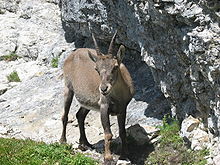Capra ibex
| Alpine ibex | |
|---|---|
 |
|
| Male | |
 |
|
| Female | |
| Scientific classification | |
| Kingdom: | Animalia |
| Phylum: | Chordata |
| Class: | Mammalia |
| Order: | Artiodactyla |
| Family: | Bovidae |
| Subfamily: | Caprinae |
| Genus: | Capra |
| Species: | C. ibex |
| Binomial name | |
|
Capra ibex Linnaeus, 1758 |
|
 |
|
| Range map in the Alps | |
The Alpine ibex (Capra ibex), also known as the steinbock or bouquetin, is a species of wild goat that lives in the mountains of the European Alps. It is a sexually dimorphic species with larger males who carry larger, curved horns. The coat colour is typically brownish grey. Alpine ibex tend to live in steep, rough terrain above the snow line. They are also social, although adult males and females segregate for most of the year, coming together only to mate. Four distinct groups exist; adult male groups, female-offspring groups, groups of young individuals, and mixed sex groups.
During the breeding season, males fight for access to females and use their long horns in agonistic behaviours. After being extirpated from most areas by the 19th century, the Alpine ibex was successfully reintroduced to parts of its historical range and all individuals living today descend from the stock in Gran Paradiso National Park in Aosta Valley and from the neighbouring French valley of Maurienne, now part of the Vanoise National Park linked to the former. These two national parks are connected and have been specially created to help the ibex to thrive. The ibex is the emblem of both the Gran Paradiso National Park and the Vanoise National Park. The species is currently listed as of least concern by the IUCN.
The Alpine ibex was first described by Carl Linnaeus in 1758. It is classified in the genus Capra (Latin for "goat") with at least seven other species of wild goat. Both Capra and Ovis (sheep) descended from a goral-like animal from the Miocene and early Pliocene, whose fossils are found in Kenya, China and Slovenia. The genus Tossunnoria appears in China during the late Miocene and appears to have been intermediate between gorals and goats. Fossils of Alpine ibex date back to the late , when it and the Spanish ibex probably evolved from the extinct Pleistocene species Capra camburgensis. The Nubian (C. nubiana), Walia (C. walie) and Siberian ibex (C. sibirica) are sometimes considered to be subspecies of the Alpine ibex, giving populations in the Alps the trinomial of C. i. ibex.
...
Wikipedia

